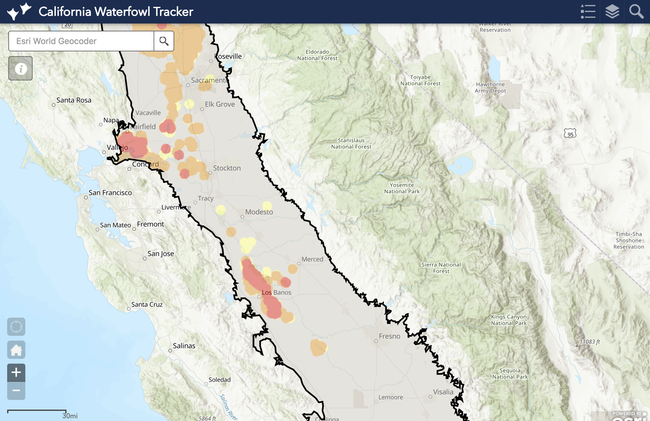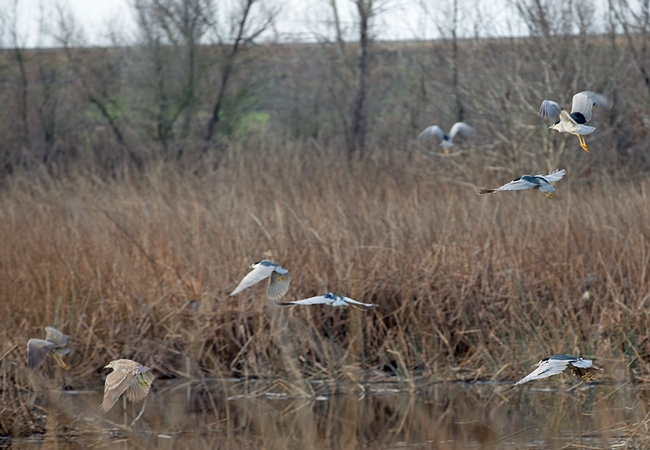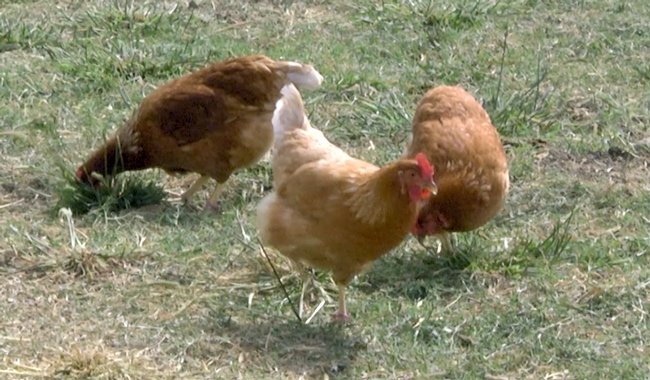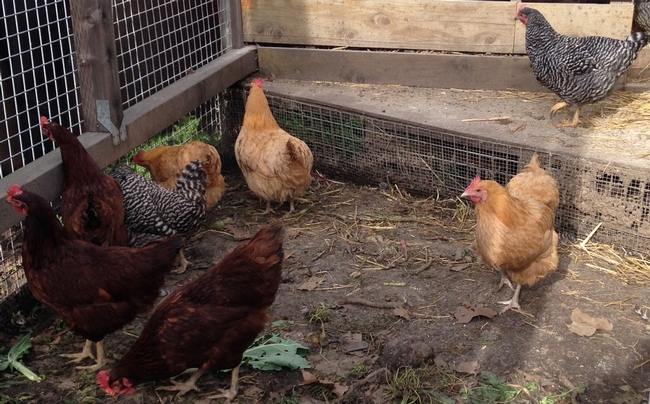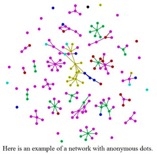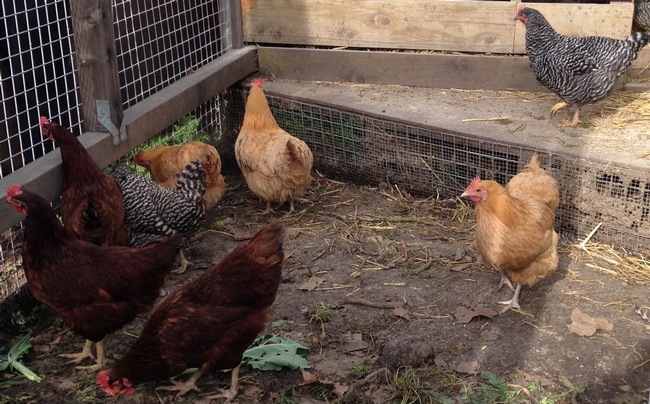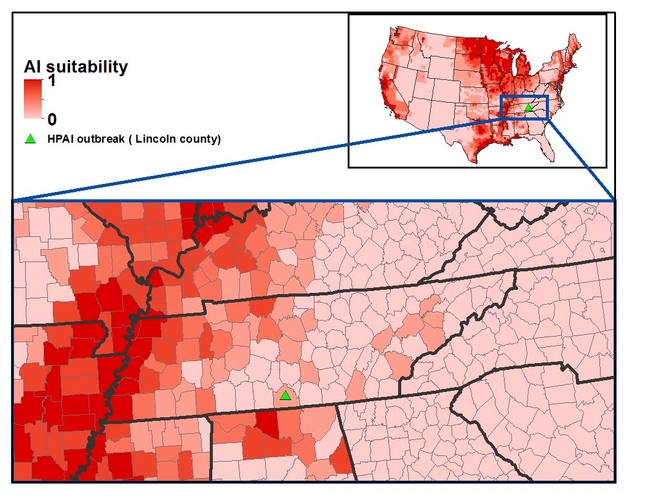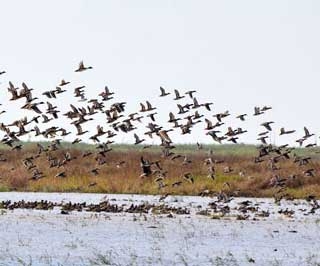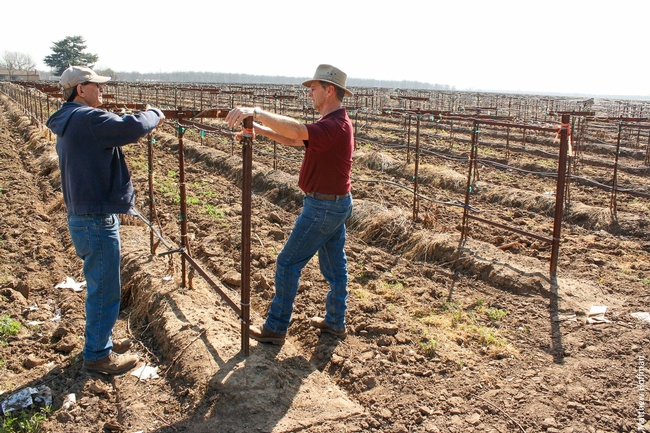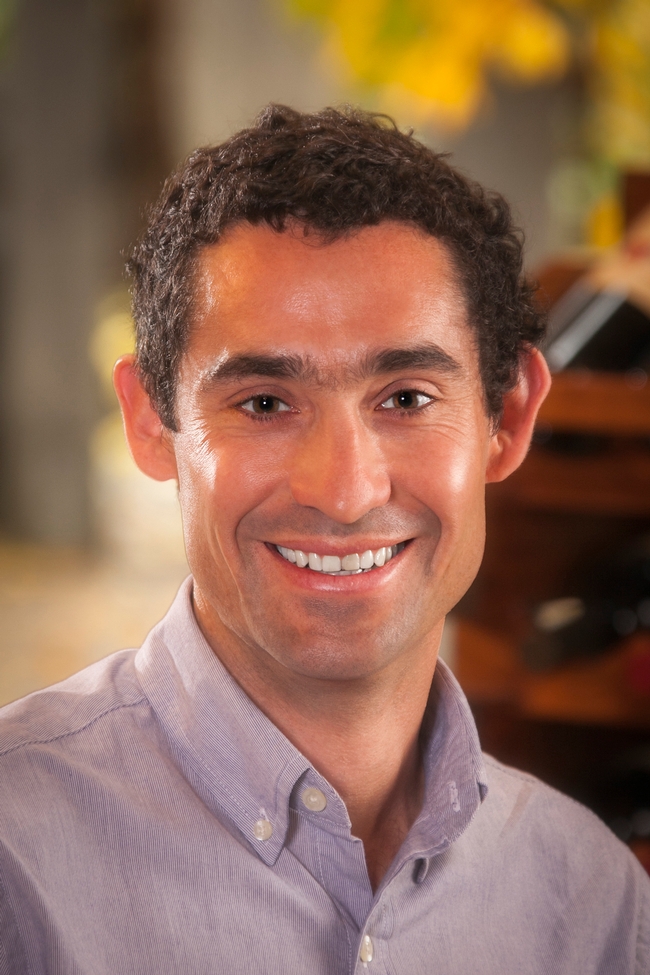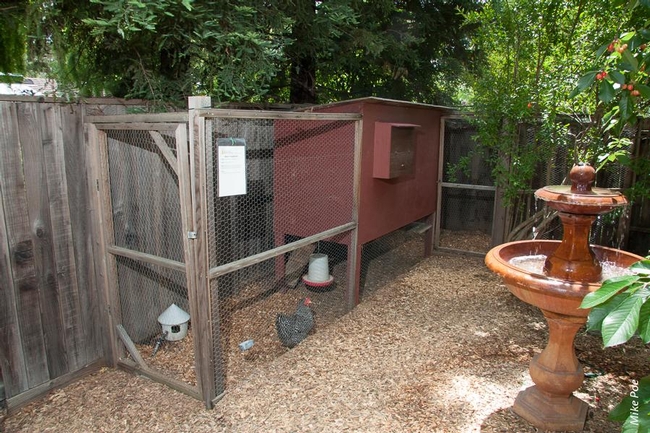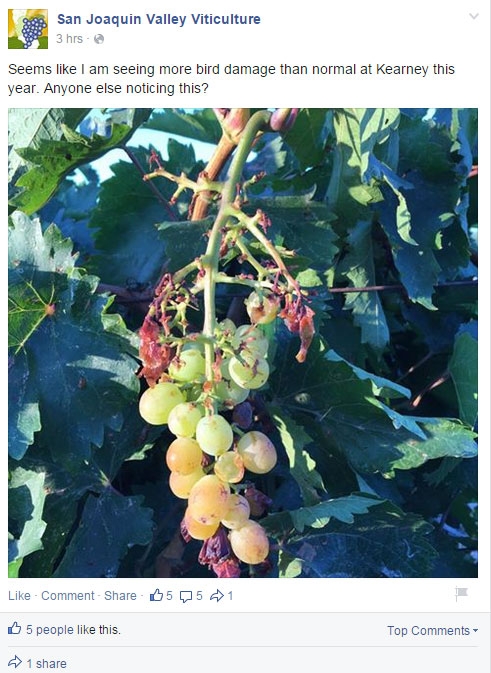Posts Tagged: Maurice Pitesky
New California Waterfowl Tracker website launched to help poultry producers assess bird flu risk
To reduce potential exposure to avian influenza, a new interactive website is now available to help California poultry producers, backyard poultry enthusiasts, regulators and risk managers assess the locations of waterfowl relative to poultry farms in the Central Valley.
While not all waterfowl carry avian influenza, the migratory birds are the primary reservoir of the virus that kills chickens, turkeys and other birds and can take an economic toll on the poultry industry. During an outbreak of a highly pathogenic strain of avian influenza in 2014-15, nearly 50 million birds had to be killed to contain the disease in the United States.
“Avian influenza is such a devastating disease, in an abundance of caution, we want to limit any interaction between waterfowl and domestic poultry,” said Maurice Pitesky, UC Cooperative Extension poultry specialist.
The California Waterfowl Tracker has been developed by Pitesky at the School of Veterinary Medicine at UC Davis, the University of Delaware, U.S. Geological Survey and UC Agriculture and Natural Resources to show where waterfowl are.
From September through March, geese, ducks and other waterfowl migrate by the millions via the Pacific Flyway and winter in California wetlands, rice and corn fields. At the height of migration, the Central Valley is home to 3 million waterfowl.
The Central Valley is also home to the majority of the state's commercial egg-laying hens, broiler chickens and turkey flocks.
Using the web app to understand when and where waterfowl are feeding and roosting, poultry farm managers and other stakeholders will be able to consider waterfowl in their decision making. They may decide to place pasture-raised poultry in a region of the state that has less wetlands, such as Fresno. If a large number of Canada geese take up residence nearby, poultry owners may decide to move their domestic birds indoors to reduce their exposure until the migrating waterfowl move on.
Using a machine-learning approach developed by Jeff Buler, University of Delaware wildlife ecology professor, the web app produces a waterfowl density map of California's Central Valley that is automatically updated daily with both satellite and weather station information.
“The model doesn't tell us whether waterfowl are carrying avian influenza, but it helps poultry producers and regulators understand where those interfaces could happen,” Pitesky said.
Additional waterfowl habitat and next-generation radar analysis of waterfowl are integrated into the web app. Users can search one or more addresses to anticipate their farms' interaction with waterfowl. Based on the proximity of waterfowl and wild bird monitoring information from the U.S. Fish and Wildlife Service, poultry owners can make biosecurity decisions.
“While the current version of the website is designed for California, the long-term goal is to develop and expand this system for the continental U.S. to promote health and safety of poultry flocks nationally,” Pitesky said.
To use the California Waterfowl Tracker, visit the UC Cooperative Extension Poultry website http://ucanr.edu/sites/poultry. A video of Pitesky demonstrating how to use the web app can be viewed at https://youtu.be/EOO0Q_ggZ9I.
Poultry producers who would like to be notified by UC Cooperative Extension if there is an avian influenza outbreak in their area can sign up on the California Poultry Census page at http://ucanr.edu/sites/poultry/California_Poultry_Census.
Backyard poultry enthusiasts invited to participate in UC research survey
Californians who raise backyard poultry are invited to participate in a study to help the University of California more effectively deliver poultry health information, especially to prevent the spread of poultry diseases.
The UC Davis School of Veterinary Medicine and UC Davis Veterinary Medicine Cooperative Extension are conducting a research study consisting of a voluntary survey designed specifically for backyard poultry owners in California.
“Our goal is to better understand how backyard poultry enthusiasts communicate with each other in California and to design and execute effective and efficient backyard poultry outreach programs,” said Maurice Pitesky, UC Cooperative Extension poultry specialist with the UC Davis School of Veterinary Medicine. “To do this, we are sending out a short survey to help us understand the ‘structure' of the backyard poultry network."
This information will be crucial in the event of a poultry disease outbreak such as avian influenza.
For example, if the researchers know which counties have a large number of birds traveling in and out, then they can focus outreach resources, such as biosecurity workshops, in those higher-risk counties. In addition, the information will guide UC scientists to plan custom workshops depending on the needs of poultry owners in specific counties.
“Please note we are a university not a regulatory agency and therefore our focus is on outreach and education, not regulation and enforcement,” Pitesky said.
If you would like to participate in this voluntary study, please fill out the California Backyard Poultry Survey at http://ucanr.edu/sites/poultry/CA_Backyard_Poultry_Survey by June 1, 2017.
If you have any questions or comments, please contact UC Cooperative Extension specialist Pitesky at mepitesky@ucdavis.edu or his research associate Myrna Cadena at mmcadena@ucdavis.edu.
Protect your poultry from avian flu
University of California poultry experts are urging poultry owners to examine biosecurity for their flocks after avian influenza was confirmed in commercial chickens in Tennessee by the USDA Animal and Plant Health Inspection Service on Sunday (March 5). To protect the birds' health, UC scientists recommend taking measures to prevent poultry from coming into contact with wild birds.
"Based on the initial sequence of the virus, the source of the virus is thought to be waterfowl, said Maurice Pitesky, UC Cooperative Extension poultry specialist in the School of Veterinary Medicine at UC Davis. “This is consistent with the current understanding of how avian influenza spreads and evolves. Specifically, juveniles are infected at breeding locations and travel south in the fall carrying virus. As the waterfowl move southward, they are more likely to interact with other species, increasing the risk of interspecies transmission and formation of new varieties of avian influenza.”
The case in Lincoln County, Tenn., is the first report of highly pathogenic H7 avian influenza in commercial poultry in the United States this year. The flock of 73,500 affected chickens is located within the Mississippi Flyway, one of four North American flyways for migratory birds.
“Lincoln County is located in one of the medium-high risk areas that were identified by our risk map, said Beatriz Martínez López, director of the Center for Animal Disease Modeling and Surveillance in the School of Veterinary Medicine at UC Davis.
“We need to increase awareness of poultry producers to maximize the biosecurity implemented in their operations, particularly in those located in high risk areas, mainly farms that are in close proximity to wetlands or other wild bird feeding and resting areas,” said Martínez López.
Poultry owners can identify biosecurity strengths and weaknesses for their own farm or backyard flock by filling out a free survey designed by Martínez López and other poultry experts. People who raise chickens, quail, ducks, turkeys, geese or other birds anywhere in the United States are invited to use the resource. At the end of the survey, participants receive specific research-based recommendations of biosecurity measures they can apply on their own types of farms. The poultry biosecurity survey is available in English http://bit.ly/2kkMycf and Spanish http://bit.ly/2mjO13G. The survey takes 15 to 20 minutes to complete and will be open until June 1.
If you would like UC Cooperative Extension to notify you if there is an avian influenza outbreak in your area, sign up on the California Poultry Census page: http://ucanr.edu/sites/poultry/California_Poultry_Census.
Owners of backyard chickens who observe illness or increased mortality among their birds should call their veterinarian or the California Department of Food Agriculture sick bird hotline at (866) 922-BIRD (2473).
For more information about raising poultry, visit http://ucanr.edu/sites/poultry.
Social networks are an important source of agricultural knowledge
These research results have broad implications for UC Agriculture and Natural Resources (UC ANR), which employs academic professionals in Cooperative Extension offices in all California counties to share science-based agricultural production information with farmers. The study suggests that education strategies that focus on farmers' social learning preferences may result in greater application of new, often more environmentally sound, production methods.
“Agriculture is a knowledge-intensive industry,” said Matthew Hoffman, the lead author of the new study. “But in the UC Cooperative Extension system, a bottleneck in the knowledge sharing network exists because of the limited number of advisors. UC Cooperative Extension is nevertheless in a great position to nurture social learning strategies and alleviate the bottleneck.”
Hoffman, who holds a doctorate from UC Davis in geography, is the grower program coordinator for the Lodi Winegrape Commission, a winegrape marketing, research and grower outreach association in San Joaquin County. Hoffman conducted the research with Mark Lubell, professor in the Department of Environmental Science and Policy at UC Davis, and Vicken Hillis, a postdoctoral researcher in Environmental Science and Policy at UC Davis.
To understand farmers' most-valued information resources, the researchers surveyed three groups of California winegrape growers – growers in Napa Valley, Lodi and the Central Coast. They asked the farmers to rate the usefulness of 21 information resources for learning about vineyard management. The list of information resources included everything from their own personal observations to advice from UCCE farm advisors, pest control advisers, trade journals, newspapers and the Internet. Each of the 21 information resources was organized into one of three learning pathways: “social” (such as peers and family, pest control adviser, and UCCE advisor); “experiential” (such as personal observations in the field, trial and error, and observations of other vineyards); and “formal” (university publications, viticulture texts, and trade journals.)
The researchers found that the 11 highest-ranked information resources were social and experiential sources. No formal learning resource was on any region's top 10 list.
“Across all regions, respondents reported that observations of their own vineyard was the most useful learning resource,” the article said. “PCAs, vineyard field crew and other winegrape growers (not family) – all social learning resources – were the second, third and fourth most useful learning resources, respectively, across the regions.”
These results indicate that grower learning is grounded largely in personal experience and knowledge-sharing relationships. Hoffman coined the term “network-smart extension” for the extension strategies that take advantage of farmers' social learning preferences. The approach, he said, capitalizes on the social process of knowledge sharing that naturally takes place among a community of growers.
“Folks are going to share information with one another regardless, the trick is knowing how to accelerate this process by leveraging the network so that those with questions can get in touch with those who have solutions,” Hoffman said. “Network-smart extension can also be defined by its underlying principles. For example, one of the principles is that growers must know what others know. Before people can start asking around for advice about a particular agricultural problem they have, it helps to know who has the expertise they are seeking.”
(The California Agriculture journal article contains a detailed description of network-smart extension.)
In collaboration with Rodrigo Gallardo from the UC Davis School of Veterinary Medicine, the UC ANR Cooperative Extension poultry specialist at UC Davis, Maurice Pitesky, recently consulted with Hoffman to use network-smart extension to share poultry health information. Raising backyard chickens has become increasingly popular. Since the birds are susceptible to poultry diseases, such as avian flu, Exotic Newcastle disease and Salmonella, which can threaten the health of people and of commercial poultry, it is imperative they have sources of accurate chicken health information. But with no ANR poultry advisors in California counties and over 100,000 backyard poultry premises in California, the information must be sent through other channels.
With a grant from the California Department of Food and Agriculture, Pitesky and Gallardo organized 2-day “train the trainer” sessions in northern and southern California in 2015 for 4-H advisors, UCCE advisors, agricultural commissioners, feed store managers, veterinarians and others. As part of the grant, Pitesky and Gallardo are working with Hoffman to learn social network analysis, the same method used to collect the knowledge-sharing network data from winegrape growers, to identify the network of collaborations among backyard poultry professionals in California. This network data will help identify those positioned to spread science-based backyard poultry information.
“The goal is to create a network of people who have some knowledge of poultry, who can then connect with their social networks and disseminate the latest information about nutrition, food safety, welfare, poultry health and biosecurity,” Piteskysaid.
Pitesky also created a poultry website to help backyard poultry producers find connections.
“There is a flow diagram, so if you have a food safety question, or a question about ectoparasites, you know who to contact,” Pitesky said. “It's hard to find veterinarians who treat backyard poultry. Our site has a list of 12 veterinarians in six California counties that treat poultry. The goal is to list vets in every county who can treat those birds.”
The scope of Pitesky and Gallardo's network-smart extension is much larger than the scope of a typical farm advisor nurturing connections between PCAs, farmers, consultants and allied industries. Hoffman offers some suggestions of how those connections can be encouraged.
One simple practice is regularly providing nametags for participants at extension field days and meetings.
“The principle is that you have to reduce the barriers to social interactions,” Hoffman said. “I'm less inclined to introduce myself if I don't know their name or I'm embarrassed because I talked to them before, but don't remember their name. Nametags grease the skids for social interaction.”
Another approach Hoffman has used in the Lodi Winegrape Commission's blog called the “Coffee Shop.”
“I have been very intentional about introducing the authors in our blog and newsletters in a way that's as personal as possible, including a photo of the author and contact information,” Hoffman said. “Even though it's not a face-to-face interaction, readers will know the name and face of the person and can contact that person if they have questions.”
A third simple approach is providing meeting flyers with a duplicate copy for a neighbor.
“The same people tend to come to every single meeting,” Hoffman said. “I'm trying to tap into the network by using people who already trust us to encourage others to come to meetings.”
UC ANR Cooperative Extension viticulture specialist Matthew Fidelibus uses Facebook and Twitter to enhance the social network. He recently posted a picture of a withered grape cluster at the UC Kearney Agricultural Research and Extension Center on the San Joaquin Valley Viticulture Facebook page, which has 757 followers.
“Seems like I am seeing more bird damage than normal at Kearney this year,” he commented. “Anyone else noticing this?”
Among the responses, “Starlings and blackbirds will take whole berries. If you see broken berries and skins left, could be finches.”
Fidelibus advertised his upcoming grape field day on his Twitter feed, which has 1,474 followers.
Generally, Hoffman said, engaging in network-smart extension isn't about individual specific practices, but an overriding principle of the program that emphasizes building relationships among practitioners and encourages their engagement within their agricultural community.
“There may be no single or best way to accelerate the natural process of social learning, but extension programs must be adaptive, creative, experimental and flexible in design and execution,” the article said. “Extensionists should be willing to step outside of conventional thinking about how programs can be designed.”

